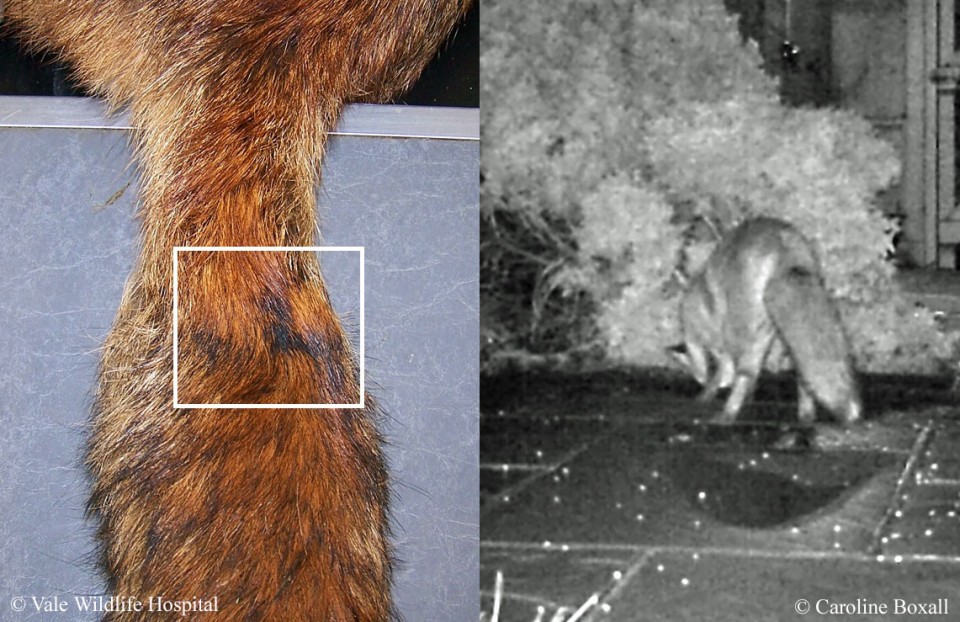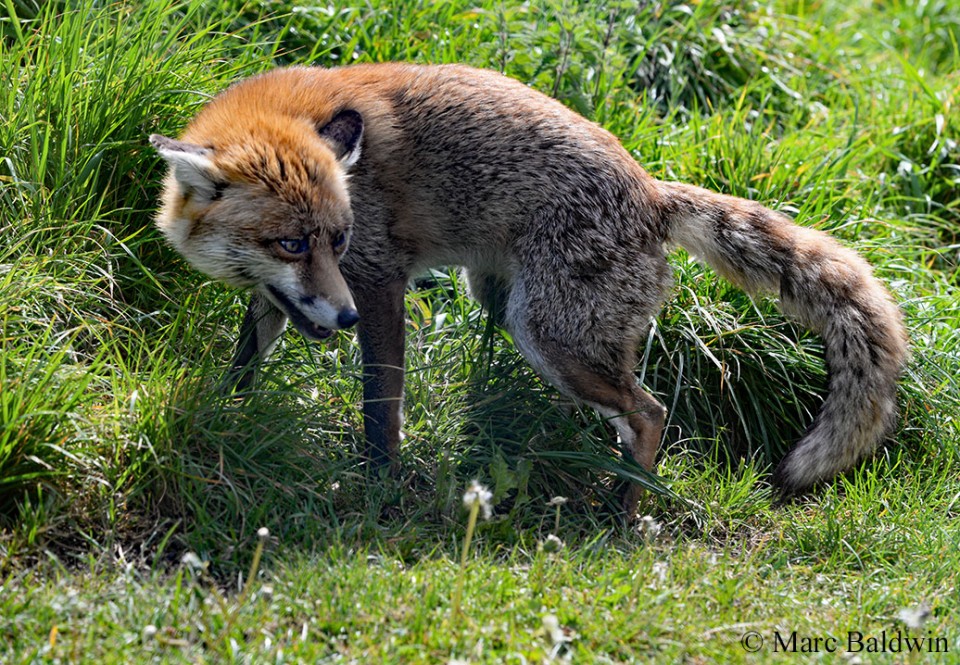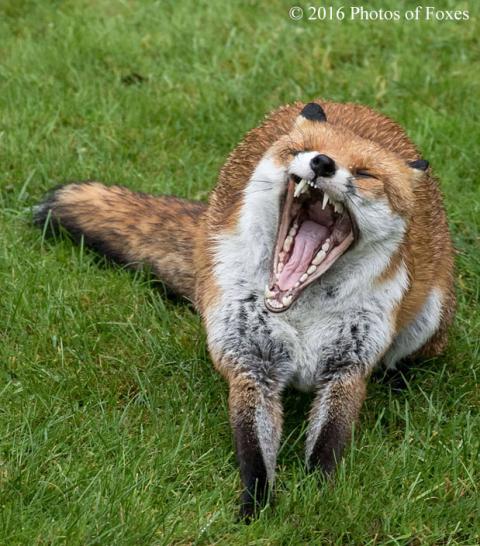Red Fox Behaviour - Communication
Foxes communicate with a variety of scent, vocal and visual cues. Scent appears to be of particular importance in fox society: territories are delimited using scent; retrieved caches are marked using scent; meeting foxes sniff each other. Many of us recognise the musty, slightly bitter scent of the fox when it affronts our nose. I've come across no entirely suitable description of the smell, but that of a newly-opened jar of coffee is perhaps my favourite.
Scent
Much has been said of the smell of the fox, including that it varies according to how scared the animal is, the season (February and March being the peak of the smell) and even by sex; some veteran hunters have apparently successfully identified a vixen in late pregnancy in an earth by smell alone. This scent comes from a variety of sources and I don't plan to cover them in more than summary at this juncture - a fuller treatment is provided in an associated Q/A. Sufficed to say, data collected by Eleanor Kean at Cardiff University suggests that fox scent is a more complex mixture of chemicals than first thought - her preliminary GC-MS scans of swabs taken from fox cheek and anus glands has identified in excess of 80 different compounds.

Foxes are well endowed with scent glands, including a pair of anal sacs that sit either side of the anus and are connected to it by a short duct, glands along the angle of the jaw, sebaceous glands across the skin, and a particularly interesting oval-shaped gland that sits about 8cm (3 in.) from the root of the tail, called variously the supracaudal, caudal or violet gland. The latter of these names appears to come (this is the earliest reference I have found, at least) from a book, written in Latin by German physician Caspar Schwenckfeld and published in 1603.
Schwenckfeld described how this gland 'smells like March violets' to help foxes deceive hunters. This supracaudal gland appears particularly active during the breeding season, when its lipoprotein secretion stains the hair above it dark. Foxes have been observed sniffing each other's glands when they meet, suggesting the scent encodes personal information about its owner. Glands on the paws between the toes are deep, have a reddish tinge and smell strongly to the human nose, although it has yet to be demonstrated whether the feet have a scent-marking function.
The urine of a fox is pungent and its smell can be long-lasting. In his appraisal of foxes in suburban London, William Teagle wrote that he bottled some fox-scented sawdust in a screw-top honey jar and it still smelt strongly five years later. Urine is known to play an important role in fox territory marking and individuals have been observed to urinate on each other, particularly during the breeding season. During courtship, dog foxes may also mark vixens with scent from their violet and anal glands or urinate on them. Data from Carl Soulsbury and John Fawcett suggest scent marking may play a role in group affiliation, with females that remained in the area they were born scent marked more than those that dispersed.
It should be noted that we often describe fox scent marking in terms of specific gland used, and this can imply they're applied under different circumstances. While this is often true, scent may also be layered, both over time and during a single scent marking event. Faeces may be urinated on later in the night or the following night, for example. Additionally, I have trailcam footage of an adult fox jowl marking (i.e., applying scent from the intralingual glands around the mouth) a plant stem before urinating against it and continuing its patrol.
Body language
As we have seen, changes in body language or facial expression that may appear subtle to us convey a wealth of information to other foxes about the individual's mood, and can be used to settle disputes without the need for direct conflict. Indeed, the colouration of the fox may even have evolved to help communicate these body language messages. Henry was of the opinion that the light buff colour of the inner ear and the black of its back could be used like a semaphore system—rather than using two flags and various arm positions, the fox uses ear positions (with each position having a unique colour code) to signify its intentions to another fox. In addition, he considered that the white tip to the brush could act as a very obvious “white handkerchief” of surrender:
“I think the white tag of the tail combined with tail lashing has evolved as an attention-getting display that is effective even under reduced visibility.”

Classic dominance and submissive body language is apparent in foxes from a very early age and is often easy to see if you feed foxes and have more than one individual visiting at a time. In cases where several foxes are feeding on the same highly localised food source (such as that at many garden feeding stations), some are clearly dominant over others. Along with some of the body language described above go various vocalizations. Indeed, the body language only tells part of the story; the noise that the fox makes while exhibiting a posture can alter the message being conveyed, and vocalisations are crucially important in fox society.
Vocalisations
In 1963, German ethologist Gunter Tembrock documented 28 different types of call with an audible range of 100 Hz to 5,000 Hz; these included different calls for greeting, submission, alarms, contact, etc. More recently, in a 1993 paper to the journal Bioacoustics, Nick Newton-Fisher and his colleagues provided an analysis of fox vocalisations, based on 585 recordings. Using these recordings, and their observations of fox vocal behaviour in the field, Newton-Fisher and his team were able to identify 20 different types of call, eight of which are used exclusively by cubs—the majority of the adult calls were barks/yell barks. Subsequently, in an article in the February 2004 issue of BBC Wildlife Magazine, Stephen Harris wrote that foxes make “more than 20 different call types”, calling throughout the year but being most vocal in winter.
The wow-wow-wow contact call of the Red fox. - Credit: Marc Baldwin
An audio clip of Red foxes fighting. The noise can sound murderous, but serious injury is rare. - Credit: Marc Baldwin
The audio from trailcam footage of a fox dispute with a cat. The fox was on the ground and the cat on a wall looking down. The fox had ears flat on head and tail curled to side of body. At no time did the fox attack the cat. The audio is amplified for clarity; vocalisations were soft. - Credit: Caroline Boxall
An example of a series of very soft coughs and growls made by a vixen to her cub. This is a composite from several trailcam videos taken over the same night in June 2018 and has been amplified for clarity. - Credit: Caroline Boxall
The "gekkering" noise made by two adult foxes during a fox trot dispute. The individuals rise on their hind legs, each with its paws on the other's shoulders, mouths agape, as they push each other back and forth. - Credit: Paul Cecil
The winter contact bark of a Red fox. While made almost exclusively during winter, my experience has been that this is made during cold weather much more frequently than mild. - Credit: Adele Brand
Submissive vocalisations between two subadult dog foxes from the same litter. - Credit: Nicky Vines
Submissive noises made by one Red fox vixen to another at a feeding station. - Credit: Jeannie Cooper
A fox vixen screaming while moving around territory. - Credit: Stephanie Powley
An excited vixen submissively screaming during the mating season. The call varies in intensity and is more often heard towards the end of the breeding season when unmated vixens haven't been mated. Note that the first part is very similar to the winter bark, before it screaming ensues. - Credit: Michele Green
A curiously plaintive "wow" call made by a young vixen. The observer was unsure whether this was grief-associated (the vixen was calling while laying on her brother's favourite sleeping spot after he'd been chased away by a new adult male) or she was distance-calling another fox as a distant response was heard. The observer reported having heard this individual make the call twice. - Credit: Mary Hinxman
Unlike many canids, foxes aren't biphonic; they produce only low frequency sounds—i.e., they can whine and yap, but can't make the squeaking noises that canids such as dholes are able to produce. Generally speaking, newborn cubs produce a “whelping” noise, which develops into a more rhythmic “yelping” by about three weeks old; the whelping and yelping are used by the cub when it needs attention or if it becomes isolated. Similarly, a lonely cub will produce a warbling noise. The vocal repertoire changes and broadens as the fox matures and, in Red Fox, Huw Lloyd described how the whining “care call” of cubs develops into a series of infantile barks by about 19 weeks of age and serves as a contact call in the weaned cubs moving outside the earth. At about a month old, the cubs use a threatening/defensive open-mouthed hissing/spitting “call”, which Lloyd notes turns into the open-mouthed combative gekkering used by adults while fox-trotting.
A vixen will issue a sharp 'cough' at the earth that will send the cubs scurrying for cover and will summon the cubs, often to feed, with what is often referred to as a low 'growl' (variously described as a “mew”, “churr” or “purr”) that often involves a vibration of the stomach. Interestingly, there appears to be much subtle information contained within this call and Mike Towler has described to me how he frequently saw one of his vixens utter a “soft mew” to which only a single cub would respond, the other five ignoring her. Mike told me:
“To me it always sounded the same, but as only one specific cub would respond she clearly called by name and my hearing failed to register the difference.”

In April 2021, Paul Cecil photographed one of his resident vixens suckling her cubs in his garden, during which he described her making “constant low grunting sounds”. This is the first report I've come across of a vocalisation during suckling and would be interested to hear from readers with any similar observations.
The most commonly heard call is either the sharp 'yapping' bark (called a Staccato bark) that seems to be used by members of the group to maintain long-distance contact, or the 'wow-wow-wow' bark, which appears to be a declaration of territory ownership. The “wow-bark” can be composed of a varying number of segments; between three and seven in my experience. A low warbling version of the wow-bark call is used to signal “all clear” to the cubs, and by the male when leaving food at the earth entrance for the vixen. Some observers have reported a “clicking” or “clicketting” noise, which may have origins similar to the coughing/churring noises made in other social contexts, during mating interactions, but I have never seen or heard this - I'd be interested to hear from anyone with recordings of it.
It is apparently possible to both sex foxes and recognise individual animals based on these vocalisations, although this may be complicated because both sexes can make the various calls. That said, vixens often appear to terminate their 'wow-wow-wow' bark with a trailing 'woooow' (e.g., 'wow-wow-wow-wow-woooow'), while dog foxes end theirs more abruptly. Additionally, many authors consider the piercing “scream” to be a vixen vocalisation used to advertise her presence to a mate. In his beautifully-written booklet The Wood in Winter, John Lewis-Stempel described this “howl” as “the wail of all the bereaved, ever.”
Lloyd described foxes greeting one another with a whimpering-growl (or a whimpering-yap when submissively greeting another) and a warning bark that differed according to the proximity to the earth: near the earth it was close-mouthed, faint and sharp (akin to a “cough”); away from the earth it was open-mouthed and loud, presumably to help other pinpoint the danger. Lloyd also wrote of a hissing vocalisation:
“... a gentle hiss which is made occasionally at night by one of my captive foxes, probably the male, which elicits a quite aggressive cackle from the other. Its significance I do not know.”
Domesticated foxes appear to have quite an extensive vocal repertoire, producing many of the same sounds wild foxes do, and probably more. I have, for example, heard domestic foxes making what might be described as a soft “rolling scream/chatter”, similar to a churr but with higher pitched notes perhaps more akin to a soft growl-like vocalisation, although it doesn't have the same acoustic frequency as a growl from a domestic dog or Grey fox. I've never heard, or come across reliable reports of, a Red fox growling or snarl like a domestic dog and there is some debate as to whether foxes can actually snarl.
Foxes may call at any time of year, although they are most vocal during the breeding season (in my experience, particularly towards the end of winter). Outside of winter, however, Harris' foxes were pretty quiet; in more than 400 hours of tracking, the Bristol foxes made only 77 calls, each lasting only a few seconds. Some authors have reported distinct “voices” of foxes and David Macdonald described how:
“On one still night in mid-March I could hear five different foxes with voices as distinct as those in any human conversation.”
In addition to “conversations”, Macdonald also observed what he referred to in his 1979 paper of scent marking as “barking trails” that may be used as an audible notice of territory occupancy and/or something akin to a fox dating advert. While describing how the foxes at his study site left scent marks along well-used paths through their territory, in the paper, Macdonald also noted:
“In some cases these paths are near sleeping places and hence often travelled. In other cases they appear to be 'barking trails' and may be associated with vocal advertisement of territories.”
Unfortunately, despite initial intentions, a more formal analysis of this behaviour was never published. Professor Macdonald did tell me, however, that he “quite often saw/heard foxes in that high density area vocalising as they used particular well trodden trails”. I have heard prolonged bouts of vocalisation by foxes that appeared to move around, suggesting calling en route somewhere, but have never been close enough to directly observe them. I would be interested to know if anyone has similar examples in this species.
People often want to know what a particular call means in fox society, but sound is only part of the picture in canid communication. Anyone with familiarity of domestic dogs will know that the context in which the sound is made and the accompanying body language contributes greatly to the “meaning” of any calls - the same applies to foxes. Pet dogs will often growl and bark while playing and, if you can only hear and not see them, it's often not obvious that the interaction is amicable. Essentially, this means that we must be very careful about trying to attribute meaning to fox calls without seeing what the animal in question is up to. It may sound like two foxes fighting to the death, but that may not be what's happening at all. The subject of how foxes communicate with scent will is covered in more detail in a separate Q/A.